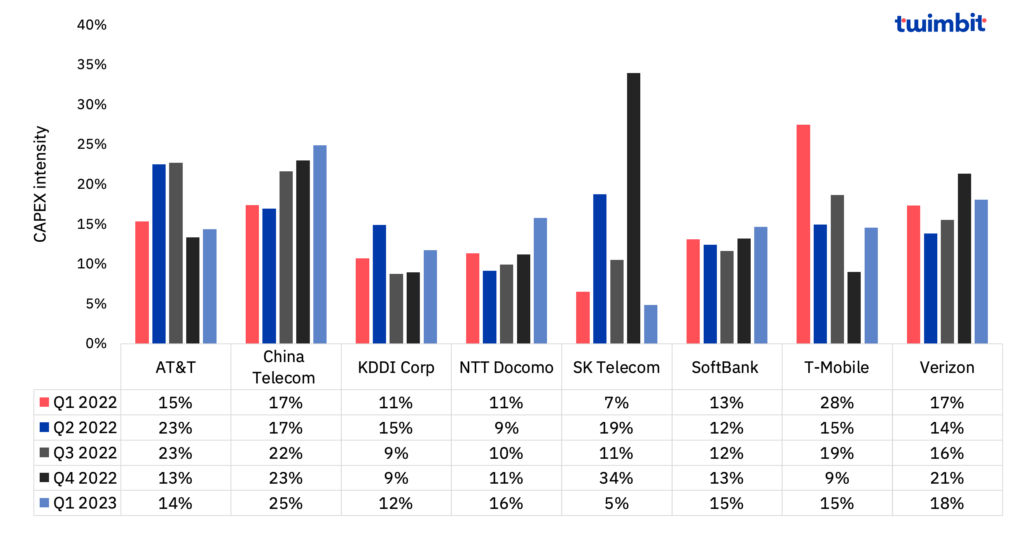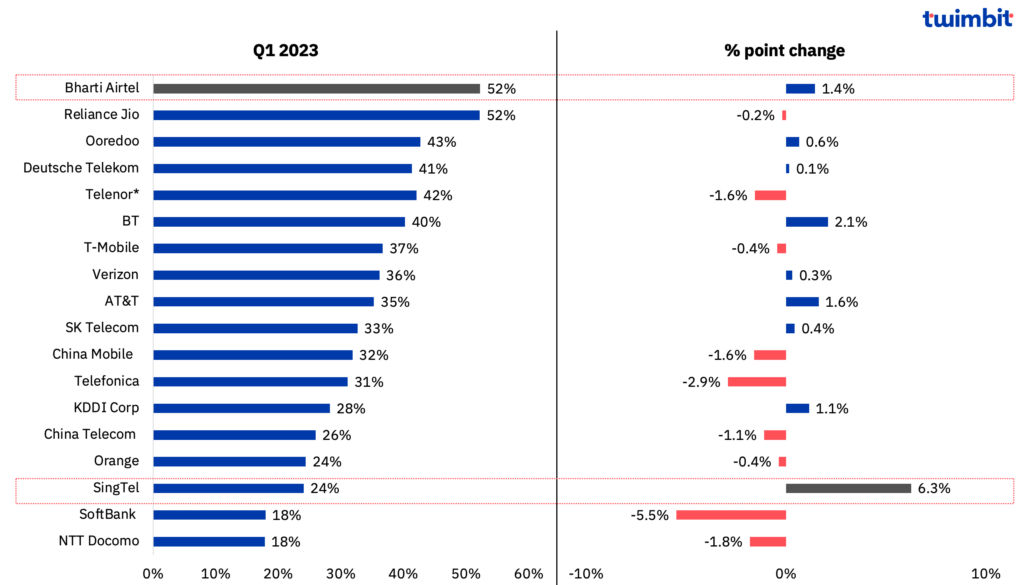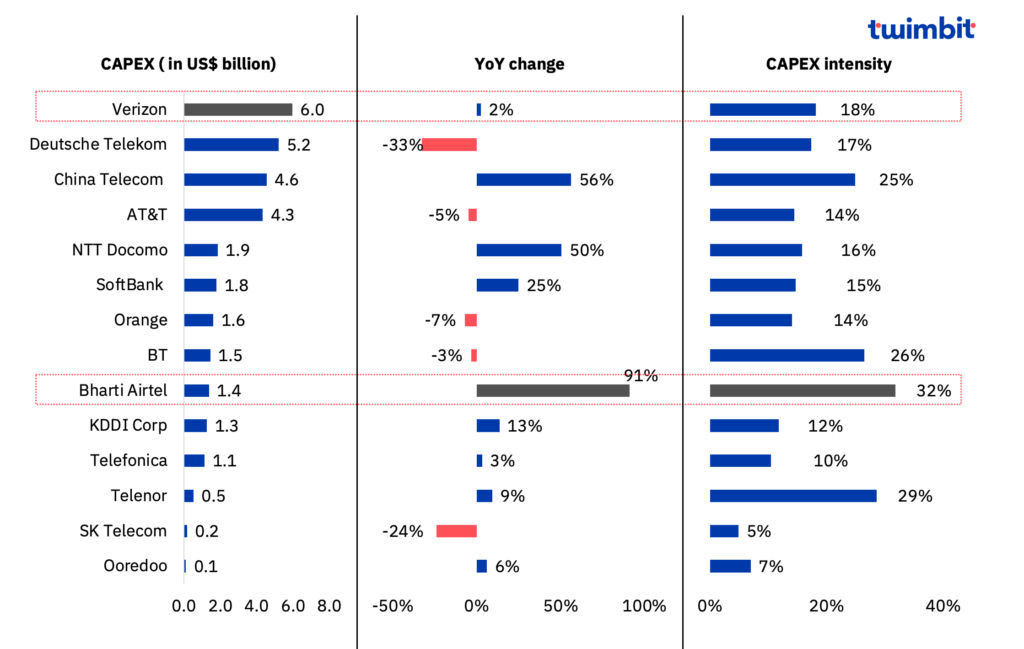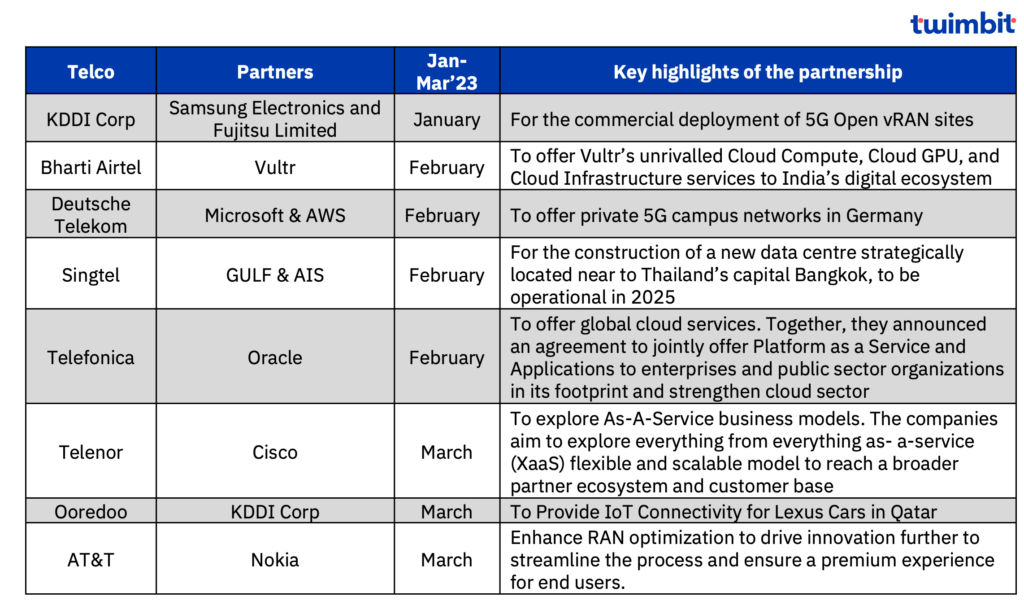Key takeaways
- In Q1 2023, the top 19 global telcos covered in this analysis experienced a modest growth rate of 3.3 percent YoY, reflecting their resilience and adaptability in the dynamic telecom industry.
- Bharti Airtel and Reliance Jio, the leading telcos in India, achieved substantial YoY growth rates of 14 percent and 12 percent respectively, showcasing their consistent positive trajectory. However, the growth rates were slightly lower compared to previous quarters.
- With 5G penetration reaching its peak in certain regions (USA, China, Japan, and South Korea) in 2022, it is not surprising that CAPEX spending for telcos declined by 130 basis points to 16.7 percent in Q1 2023.
Exhibit 1: CAPEX trends (Q1 2022 – Q1 2023)

*Note: The analysis covers world’s top 19 telcos and their performance at the group level.
- However, it is worth noting that US telcos are strategically increasing their CAPEX investment in fiber penetration, while Chinese telcos are focusing on industrial digitalization with significant CAPEX spending.
- Indian telcos have recognized the need to increase their ARPU and have set ambitious targets to achieve an ARPU of INR 250 (US$ 3.1) by 2025. This proactive approach highlights their determination to enhance profitability and drive sustainable growth in the future.
- In Q1 2023, telcos entered strategic partnerships with industry-leading companies such as Samsung Electronics, Fujitsu Limited, Microsoft, AWS, Oracle, Cisco, and Nokia to leverage the expertise and capabilities of these partners to deploy advanced 5G infrastructure, offer cutting-edge cloud services, explore innovative business models, provide seamless IoT connectivity, and enhance network optimization.
Revenue performance Q1 2023, Indian telcos continue growth momentum
- Bharti Airtel and Reliance Jio, prominent Indian telecom companies, demonstrated commendable YoY growth rates of 14 percent and 12 percent, respectively. While this growth rate represents a more modest pace compared to previous quarters, it still reflects a positive trajectory for both organizations.
- The primary driver behind the moderate growth we are experiencing is due to constrained growth in ARPU. Notably, Reliance Jio in the prepaid category, last made a substantial price adjustment of 25 percent in November and December 2021. Similarly, Bharti Airtel witnessed tariff increases of 20 percent in December 2021 and 15 percent in October 2022. Consequently, the full impact of the tariff hike has already been realised, resulting in stagnant ARPU figures for these telcos in upcoming quarter when compared on sequential basis.
- China Mobile and China Telecom continued to build on their growth momentum, achieving 10 percent and 9 percent growth rates, respectively. This growth was driven by their effective implementation of comprehensive cloudification and digital transformation strategies, which contributed to their overall revenue increase.
- Both prominent Japanese telcos Softbank, and NTT Docomo, achieved significant YoY growth rates of 11 percent and 8 percent, respectively.
- The revenue growth for NTT Docomo was driven by their expansion into various sectors, such as Real Estate and Energy, in addition to their SI services.
- Similarly, Softbank’s revenue growth was primarily due to an increased adoption of IoT devices and the implementation of higher royalty rates in the smartphone market.
- Telefonica reported growth across all business lines, with a YoY revenue increase of 7 percent. Particularly noteworthy is the strong growth in their B2B revenue, which saw a significant increase of 9 percent. Additionally, handset sales experienced a notable rise of 10.3 percent.
- AT&T experienced a positive YoY growth after reporting a revenue decline in the past three quarters. This growth can be attributed to consistent 5G and fiber customer additions, along with profitable growth driven by increasing wireless service and broadband revenue.
- Verizon, Singtel, Vodafone and T-Mobile reported a decline in revenue during Q1 2023.
- Verizon’s revenue declined by 2 percent YoY due to lower wireline and wireless equipment revenue. However, this decline was offset to some extent by growth in wireless service revenue.
- Singtel’s consumer business in Singapore showed positive momentum, driven by increased mobile service revenue, particularly from higher roaming usage, increased adoption of 5G, and growth in prepaid sales. However, this growth was insufficient to offset the overall decline in the group revenues.
- Vodafone’s revenue performance slowdown was in line with expectations and can be attributed to a decline in service revenue growth. While this decline may seem challenging, it aligns with the company’s projected forecasts.
Exhibit 2: Revenue YoY growth, Q1 2023

*Note:
1. The analysis covers world’s top 19 telcos and their performance at the group level.
2. Note: Dtac and Digi, subsidiaries of Telenor are de-consolidated and the Q1 2023 income statement figures for Telenor are reclassified
EBITDA performance in Q1 2023
- Bharti Airtel and Reliance Jio, leading Indian telcos, maintained a robust EBITDA margin (above 50 percent), showcasing their strong financial performance. Meanwhile, Softbank and NTT Docomo, prominent Japanese telcos, have demonstrated consistent growth, despite having slightly lower EBITDA margins compared to their global counterparts.
- Interestingly, almost 50 percent of the telcos covered in the analysis experienced an improvement in EBITDA margins.
- Singtel witnessed a substantial increase of 630 basis points in EBITDA margin, reaching 24 percent in Q1 2023. This performance was driven by the increased revenue from fixed broadband services, fueled by higher-speed broadband plans.
- Telefonica and Softbank were major telcos that experienced a decline in EBITDA margins during Q1 2023.
- Telefonica encountered a decline of 290 basis points in EBITDA margin, primarily attributed to a one-time capital gain recorded in Q1 2022. However, this decline was partially offset by positive forex effects and lower restructuring costs.
- Softbank’s EBITDA margin decreased by 550 basis points, mainly due to a one-time gain resulting from the step acquisition involving the conversion of PayPay Corporation into a subsidiary.
Exhibit 3: EBITDA performance, Q1 2023

*Note:
1. The analysis covers world’s top 19 telcos and their performance at the group level.
2. Note: Dtac and Digi, subsidiaries of Telenor are de-consolidated and the Q1 2023 income statement figures for Telenor are reclassified
5G deployments continued to increase CAPEX for telcos
- With 5G penetration reaching its peak in certain regions in 2022, it is not surprising that CAPEX spending for telcos declined by 130 basis points to 16.7 percent in Q1 2023, which reflects the industry’s focus on optimising investments in line with market needs.
- Despite the overall decline in CAPEX spending, several telcos demonstrated remarkable growth in this area. Bharti Airtel, China Telecom, and NTT Docomo were among the leaders, with their CAPEX increasing by more than 50 percent YoY.
- Bharti Airtel achieved an impressive 91 percent increase in CAPEX globally, primarily driven by their aggressive 5G deployments in India. In fact, their operations in India witnessed a remarkable CAPEX growth of 110 percent.
- China Telecom directed a significant portion of their CAPEX, which grew by 56 percent to US$4.6 billion, towards industrial digitalisation initiatives. They have ambitious plans to further increase their spending by 40 percent by 2023.
- On the other hand, Deutsche Telekom and SK Telecom were major telcos that witnessed CAPEX decline in Q1 2023.
- SK Telecom, having already reached peak penetration with 5G, gradually reduced their CAPEX over the years, aligning their investments with the maturity of their network.
- Deutsche Telekom’s CAPEX was primarily impacted by their US operations, which faced a significant decline of 51 percent. This decrease was a result of higher cash outflows in 2022 for the accelerated build-out of their 5G network and the integration of Sprint. However, in other markets, their CAPEX spending remained stable or even showed a slight increase, highlighting their strategic allocation of resources.
Exhibit 3: CAPEX performance, Q1 2023

*Note:
1. The analysis covers world’s top 19 telcos and their performance at the group level.
2. Note: Dtac and Digi, subsidiaries of Telenor are de-consolidated and the Q1 2023 income statement figures for Telenor are reclassified
ARPU trends in Q1 2023
- Indian telcos i.e., Bharti Airtel and Reliance Jio showcased impressive ARPU growth momentum in Q1 2023, with YoY increase of 8.4 percent and 27 percent respectively. Notably, Indian telcos have set ambitious targets to further raise their ARPU to INR 250 (US$ 3.1) by 2025.
- AT&T, experienced a 2.0 percent YoY increase in ARPU, reaching US$ 55.1. This growth can be attributed to improved international roaming services and a strategic shift towards higher-priced unlimited plans.
- Japanese telcos, operating in a mature and saturated market, witnessed a decline in ARPU as they reached peak penetration. This shift in ARPU trends is a natural progression in a saturated environment. However, these telcos anticipate stabilisation in the upcoming quarters.
Exhibit 4: ARPU performance, Q1 2023
Major Partnerships by telcos in Q1 2023
Exhibit 5: Major partnership in Q1 2023
Thank you for reading! Reach out to us for any feedback
You might also like:
Unveiling the Best: Benchmarking APAC Telcosin Q1 2023
Benchmarking the performance of the top 5 telecom equipment vendors in Q1 2023










